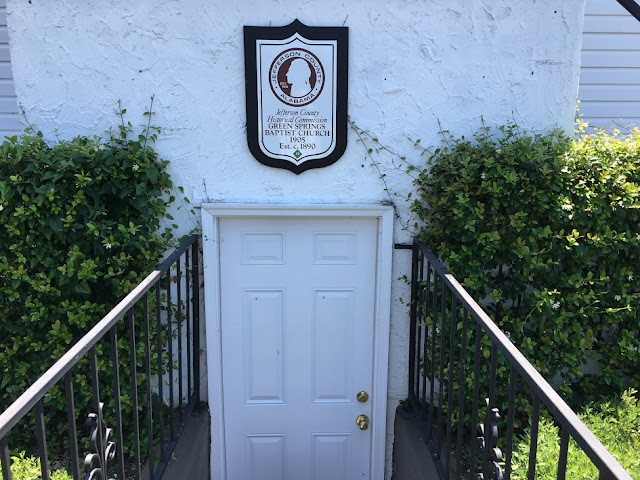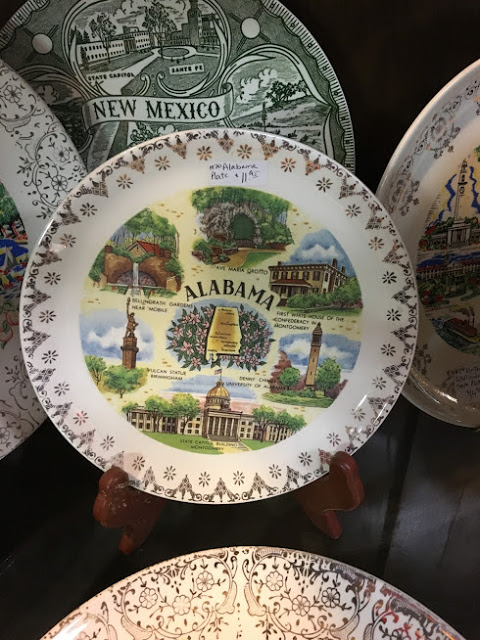Babs and Borden Deal were a rare couple among writers--two very successful novelists from the 1950's through the 1970's. And since then they have both slipped into obscurity. Let's investigate their Alabama connections.
Babs Hodges was born in Scottsboro on June 23, 1929. After high school graduation she worked in Washington, D.C. as clerk/typist and as typist at Anderson Brass Company in Birmingham. She received a B.A. from the University of Alabama in 1952. Both she and Borden studied under legendary author and professor of creative writing Hudson Strode, although not at the same time. Strode taught at UA for more than 25 years and his students went on to publish over 50 novels and hundreds of short stories.
She and Borden married in 1952 while both were in Tuscaloosa; Babs was his second wife. They divorced in 1975. The couple had three children, son Brett and daughters Ashley and Shane.
During much of their marriage they lived in Sarasota, Florida, where they circulated in the company of other writers including well-known crime and suspense novelist John D. MacDonald. Rumors of an affair between MacDonald and Babs resulted in MacDonald writing a letter to Borden denying it. [See Hugh Merrill's biography of MacDonald, The Red Hot Typewriter, 2000]
Borden was born in Pontotoc, Mississippi, on October 12, 1922. After graduation from high school he joined the Civilian Conservation Corps, where he worked on firefighting crews in the Pacific Northwest. He served in the U.S. Navy from 1942 until 1945, and then entered the University of Alabama and studied under Strode. He graduated with a B.A. in 1949. He moved to Mexico City College for graduate work; there he met his first wife. They had one child, but soon divorced.
The Deals remained in Tuscaloosa for a couple of years after the marriage and spent their time writing. Future author Wayne Greenhaw often watched the children so the pair could work. By 1954 the Deals were living in Scottsboro. While there Borden received a Guggenheim Fellowship in 1957 and a residency at the MacDowell Colony for artists in New Hampshire in 1964. That same year the family moved to Sarasota. By that time Borden had published eight novels and Babs her first two.
Deal published over 20 novels and around 100 stories during his life. Some were published under pseudonyms. After 1970 he also wrote a series of erotic novels published anonymously, a practice many authors have used to supply quick funds. Two of his novels appeared posthumously, They Are All Strangers (1985) and The Platinum Man (1989). Babs published twelve novels.
Borden died of a heart attack in Sarasota on January 22, 1985. Babs, who lived at the time in Gulf Shores, died in a Montgomery hospital on February 20, 2004.
I never met Borden or any of the children, but I did meet Babs in the late 1970's. She was living in Auburn while her daughters were in school there. She and Dianne were friends when I met my future wife, who hadd met Babs through daughter Ashley. I remember Babs as a funny, earthy lady.
Borden has entries in Wikipedia and the Encyclopedia of Alabama; Babs has neither. In his 2001 book Vanishing Florida, David T. Warner includes a memoir of Borden whom he knew in Sarasota. Babs does have an entry in the Alabama Literary Map and like Borden appears in various reference books covering Southern and/or American authors. Borden's papers are in the Howard Gotlieb Archival Research Center at Boston University. That collection includes sculptures of Babs and Borden by Sara Mayfield, a fellow Alabama writer.
Alabama has had at least two other couples who were both widely published authors, C. Terry Cline and Judith Richards and the Covingtons, Dennis and Vicki.
Further comments follow many of the images below.
This novel, Babs' fifth, first appeared in 1968. The following year she received the Alabama Author Award from the state library association for the book. Dianne has told me Babs once informed her that the book was loosely based on real Tuscaloosa events.
On December 3, 1979, NBC broadcast a TV movie adaptation of that novel under a new title. The film featured an all-female cast that included Paula Prentiss, Tina Louise, Loretta Swit, Stella Stevens, Shelley Fabares and Sondra Locke.
A TV-movie tie-in reprint of the novel appeared in 1979.
Her first novel appeared in 1959.
Babs' second novel, originally published in 1961, was reprinted by the University of Alabama Press in 1990. That is the most recent reprint of any of her works. In its review of the reprint, Library Journal declared, "This is a southern writer who can be appreciated by all." (15 September 1990, p. 105)
This thriller was published in 1973.
Source: Find-A-Grave
Her 1969 country music novel is dedicated to friend, fellow writer and onetime baby sitter Wayne Greenhaw, who has left a remembrance of the Deals in his essay in The Remembered Gate: Memoirs by Alabama Writers. The book was "really about Hank Williams" she told Clarke Stallworth in the article discussed below.
In this 1962 novel, Deal's characters all work at night.
This novel appeared in 1975.
Other novels include The Grail (1964), Fancy's Knell (1966), Summer Games (1972), The Reason for Roses (1974) and Goodnight Ladies (1978). The Grail was a football novel in which the star quarterback falls in love with the coach's wife. The book is based on the legends of King Arthur; for background on football she consulted Bear Bryant and Gene Stallings.
This article by Clarke Stallworth appeared in the Birmingham News 26 March 1982. In it she laments the "bestseller" mentality of publishers and notes that after 25 years her publisher Doubleday doesn't "want me any more." She mentions the completed manuscript for a thirteenth novel. Perhaps it is among her papers, also at the Howard Gotlieb Archival Research Center at Boston University.
Her published short fiction includes:
DEAL, BABS H(odges) (1929-2004) (chron.)
- * A Chocolate Cake, (vi) Redbook Jul 1964
- * The Crystal Mouse, (sl) Ladies’ Home Journal Feb 1973
- * High, Lonesome World, (ss) Cosmopolitan Jun 1963
- * The House Guest, (ss) Alfred Hitchcock’s Mystery Magazine Jul 1967
- * Make My Death Bed, (ss) Alfred Hitchcock’s Mystery Magazine Apr 1960
- * Pride, (vi) Redbook May 1964
- * To Ride an Elephant, (vi) Redbook Aug 1965
- * The Twilight Corner, (ss) McCall’s Feb 1961
- * With Love from Joe, (ss) Redbook Jan 1964
On June 27, 1961, an adaptation of her story "Make My Death Bed" appeared on the Alfred Hitchcock series. The thirty-minute program was broadcast in the show's sixth season. As of this writing a video of the episode is available here.
This anthology published in 1976 contains Deal's story "A Try for the Big Prize" that first appeared in Hitchcock's magazine in May 1961.
This 1959 novel about southern hill country music served as the basis of the Broadway musical A Joyful Noise in 1966.
This novel appeared in 1965.
This novel was published in 1974.
The Advocate (1968) is the middle novel of a "political trilogy" that also included The Loser (1964) and The Winner (1973).
As he had done with the early novel Dunbar's Cove and the TVA, this 1970 book explored the effects of massive change on the South. In addition to that theme in his novels, Deal also wrote about basic human characteristics such as ambition, lust, greed, infidelity and a young man's coming of age.
This photograph on the back cover of Interstate was taken by fellow author John D. MacDonald.
The first part of this Walt Disney's Wonderful World of Color episode was broadcast on March 8, 1964, and the second part a week later. The film was based on a story by Borden, probably "Watermelon Moon" first published in Argosy (UK) in February 1963.
Borden's published short stories include:
- * Beauregard Bugleboy III, (ss) Argosy (UK) Sep 1965
- * The Big Bajoor, (ss) Alfred Hitchcock’s Mystery Magazine Jun 1962
- * A Bottle of Wine, (ss) Alfred Hitchcock’s Mystery Magazine Dec 1956
- * The Cattywampus, (ss) Argosy Jan 1963
- * The Christmas Hunt, (ss) The Saturday Evening Post Dec 3 1960
- * Cornered, (ss) Argosy Dec 1951
- * The Day the Lion Came to Town, (ss) McCall’s May 1962
- * Death of a Lawman, (ss) Verdict Jan 1957
- * Death on the Avenida, (vi) Collier’s Sep 16 1955
- * Dunbar’s Cove, (n.) Scribner’s 1957
- * Flesh-Eaters, (ss) Argosy (UK) Jul 1960
- * The Followers, (ss) Alfred Hitchcock’s Mystery Magazine Aug 1958
- * The Frightened Ones, (ss) Adventure Apr 1956
- * Get-Away, (ss) Alfred Hitchcock’s Mystery Magazine Nov 1961
- * The Gothic Room, (ss) The Saint Magazine Sep 1967
- * Harmony Valley, (ss) Alfred Hitchcock’s Mystery Magazine Jul 1966
- * Holiday for an Unhappy Man, (ss) Alfred Hitchcock’s Mystery Magazine Jun 1959
- * Hunters, (ss) Alfred Hitchcock’s Mystery Magazine Jan 1959
- * A Kiss for Choice, (ss) 1959
- * A Long Way to Go, (n.) 1965
- * Make Your Pitch, (ss) Alfred Hitchcock’s Mystery Magazine Apr 1962
- * A Mule Named Tony, (ss) Argosy Feb 1964
- * Murder by Remote Control, (nv) Mike Shayne Mystery Magazine Nov 1958
- * My Brother’s Killer, (??) Collier’s Jul 11 1953
- * My Summer Vacation, (ss) Rogue Jul 1961
- * A Night for Hounds, (ss) Argosy Feb 1951
- * One Last Bull, (ss) Adventure May 1951
- * The Patternmaker, (ss) Rogue Jul 1963
- * The Saint, (ss) Rogue Aug 1964
- * The Secret Box, (ss) Alfred Hitchcock’s Mystery Magazine Feb 1960
- * Small-Town Cop, (ss) Mercury Mystery Magazine Aug 1958
- * Snipe Hunt, (ss) Argosy (UK) Feb 1964
- * The Steeper Cliffs, (ss) Pocket Book Weekly Nov 24 1956
- * The Strange Gig, (ss) Playboy Nov 1963
- * “The Tailor-Made Wife”, (ss) Redbook Feb 1958
- * Talk Your Way Out of Death, (ss) This Week Mar 11 1956
- * The Taste of Melon, (ss) The Saturday Evening Post Aug 25 1962
- * A Time for Knowing, (ss) Prairie Schooner Fll 1950
- * Tough Cop, (ss) Ellery Queen’s Mystery Magazine Jun 1963
- * A Try for the Big Prize, (ss) Alfred Hitchcock’s Mystery Magazine May 1961
- * Watermelon Moon, (ss) Argosy (UK) Feb 1963
- * A Woman’s Choice, (ss) Jack London’s Adventure Magazine Oct 1958
- * You Understand?, (ss) Ellery Queen’s Mystery Magazine Dec 1979
- * “Argonotes”, uncredited, (bg) Argosy Feb 1951





















































